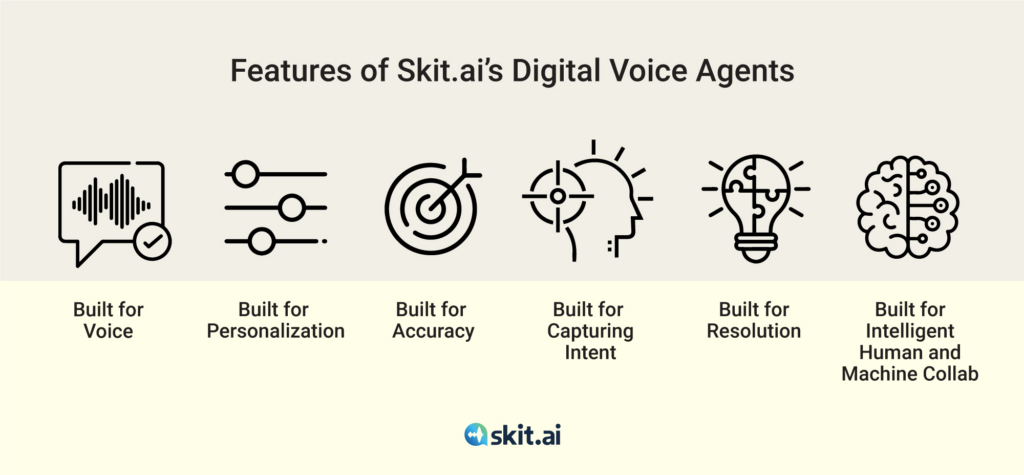Harshad Bajpai
September 26, 2022

Hello! Welcome to Skit.ai. Click here to book a demo.
For contact centers, Interactive Voice Response (IVR) systems were a turning point a few decades ago, but now have become a customer experience turn-off. IVR systems have helped companies manage call volumes as well as create value with self-service options, information gathering, and call routing. But a recent study found that, on average, IVRs cost businesses $256 per customer each year! Additionally, a whopping 61% of these customers are unhappy with IVR systems and believe they contribute to a poor customer experience.
“About 83% of the customers abandon the call and company after their IVRs encounters.”- Vonage report.
Historically, IVRs have failed to delight callers due to the poorly designed phone menu and the inability to dispense an answer or connect an agent on the go. Companies and businesses receive a lot of flak due to the general notion of associating IVRs as cost-effective replacements for contact center agents. It is paradoxical that customers warmly accept other forms of automated, self-service options for an instant response like ATMs and a variety of mobile applications but not IVRs!
The reasons for it are pretty simple. Since their introduction into the contact center market, IVR systems have undergone few iterations, and their main features haven’t changed much. The hold time, lengthy pre-recorded menus, and the need to repeat query information, especially during an emergency, continue to be a liability for businesses. More importantly, customers have a strong affinity for resolving queries with a human representative than with restrictive, pre-recorded systems that only leave them with unsavory emotions towards the brand.
Nearly 47% of callers reportedly experience frustrations with IVRs. A significant number of them admitted feeling angered and stressed, according to the Vonage report.
The same report also revealed that instead of IVRs, if the customers were able to get a hold of a live agent, they experienced relief (27%), less frustration (26%), and less anger (24%). However, call center agents often end up at the receiving end of customer frustrations from navigating a labyrinth of IVR menus. Therefore the onus is on brands to elevate customer experiences without negatively impacting agents’ morale and productivity.
In this article, we share our insights on overcoming common contact center and customer experience challenges associated with traditional IVRs by diving into the capabilities of Voice AI. We will explore how brands can elevate their customer support with intelligent voice automation of nearly 70% of calls and human-like conversations.
Explore Now: AI-powered Digital Voice Agents vs Outbound IVRs
Imagine a scenario—a customer calls a banking company’s contact center to block their stolen debit card. In lieu of pre-recorded messages and caller authentication protocols, the call is handled by a voice agent that is capable of contextually comprehending the caller’s urgency and making appropriate suggestions. The overall call experience is different! Why?
That’s our Digital Voice Agent (DVA) at work. Skit.ai’s DVA, for instance, is an AI-enabled virtual agent built from the ground up to understand human conversations. It can be plugged into contact centers to resolve tier 1 customer problems and automate cognitively routine work.

A Deep Dive: AI-powered Digital Voice Agents vs IVRs
Now, let’s look into 7 specific angles where Skit.ai’s purpose-built, industry-specific voice-first technology, Voice AI, makes a tremendous difference to contact centers. Skit.ai’s voice agents are a better fit than traditional IVRs in enhancing the quality of customer service.
Read in Detail About–Digital Voice Agents: What, Why, and How
Despite several detractors that customers unanimously agree on, IVR systems remain a staple in customer support. The worldwide growth rate of the IVR market is expected to reach $6.7 billion by 2026. This growth trajectory can be a blessing to CTOs who chose IVRs for long-term customer service investments, but certainly a nightmare for CMOs against the backdrop of increasing customer calls. Technological innovation and AI-driven upgrades are needed to drive the progression of IVR systems. Until then, Voice AI helps empower businesses to elevate inbound and outbound initiatives for better CX in ways that IVR systems fail to live up to.
Are you interested in contact center automation with our Digital Voice Agent to elevate customer experience? Book a demo with one of our experts: www.skit.wpenginepowered.com
The auto finance industry is experiencing significant transformations driven by market dynamics, consumer behavior, and technological innovations. Here are the key trends shaping the future of auto finance, focusing on the implications for Buy Here Pay Here (BHPH) dealers and the role of Conversational AI and contact center automation in streamlining operations, which will help […]
The auto finance industry, a crucial pillar in the automotive market, experienced a turbulent Q2 in 2024. The rise of delinquent accounts in subprime lending has become a significant concern for industry stakeholders. Subprime lending, which targets borrowers with lower credit scores, is inherently riskier, and recent economic pressures have worsened these risks. This blog […]